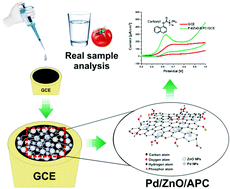
Activated Porous Carbon Supported Pd and ZnO Nanocatalysts for Trace Sensing of Carbaryl Pesticide in Water and Food Products
-
Author:
R. Jemai, M. A. Djebbi, N. Hussain, B. Yang, M. Hirtz, V. Trouillet, H. Ben Rhaiem, A. Ben Haj Amara
-
Source:
New J. Chem. 46 (2022) 13880-13895
- Date: 2022
-
Nanomaterials-based sensors are a dire need for credible and accurate determination of pesticides in water and food samples as a monitoring tool. Herein, electrocatalysts of Pd and ZnO NPs supported on a highly porous framework of activated carbons (APC) were prepared for efficient electrochemical detection of carbaryl trace. First, activated potato starch was used as a pyrolysis precursor to obtaining activated porous carbon (APC). The ZnO NPs were then growing on the APC substrate by the known sol-gel/impregnation methods, followed by in-situ reduction of Pd NPs. The as-prepared nanocomposite of Pd/ZnO/APC was morphologically and structurally confirmed by systematic physico-chemical analysis. As-fabricated Pd/ZnO/APC nanocomposites were later evaluated for the efficient sensing of carbaryl by modifying a glassy carbon electrode (GCE). The cyclic voltammetry analysis revealed the unique oxidative sensing ability of Pd/ZnO/APC for carbaryl at 0.62 V with a low ΔE (80 mV) when compared to that of bare GCE. Based on the notable sensing ability of Pd/ZnO/APC, a reliable and sensitive electrochemical method was anticipated for the quantitative and qualitative determination of carbaryl. Meanwhile, experimental parameters, including electrolyte environment and electrodeposition conditions, were carefully refined to achieve maximum sensitivity and low detection limit. Under optimized conditions, the electrochemical sensing of carbaryl is realized with a LOD of 0.01 μM in the detection range of 0.01–5.0 μM. Moreover, the sensing electrode exhibited excellent selectivity, good reproducibility, and long-term stability, which qualified the sensor to access analysis in real samples, where it also showed satisfactory performances.
